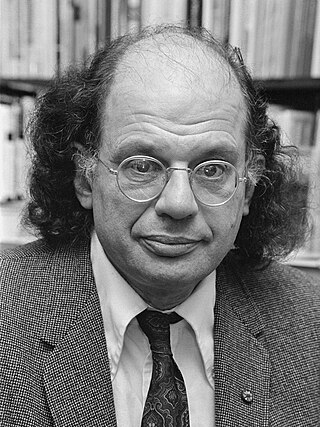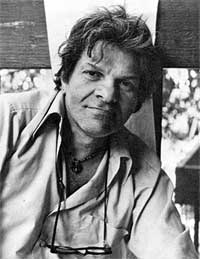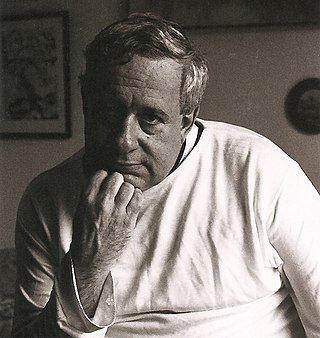
Irwin Allen Ginsberg was an American poet and writer. As a student at Columbia University in the 1940s, he began friendships with William S. Burroughs and Jack Kerouac, forming the core of the Beat Generation. He vigorously opposed militarism, economic materialism, and sexual repression, and he embodied various aspects of this counterculture with his views on drugs, sex, multiculturalism, hostility to bureaucracy, and openness to Eastern religions.

Jean-Louis Lebris de Kérouac, known as Jack Kerouac, was an American novelist and poet who, alongside William S. Burroughs and Allen Ginsberg, was a pioneer of the Beat Generation.

William Seward Burroughs II was an American writer and visual artist, widely considered a primary figure of the Beat Generation and a major postmodern author who influenced popular culture and literature. Burroughs wrote eighteen novels and novellas, six collections of short stories and four collections of essays, and five books have been published of his interviews and correspondences; he was initially briefly known by the pen name William Lee. He also collaborated on projects and recordings with numerous performers and musicians, made many appearances in films, and created and exhibited thousands of visual artworks, including his celebrated "Shotgun Art".
The Beat Generation was a literary subculture movement started by a group of authors whose work explored and influenced American culture and politics in the post-war era. The bulk of their work was published and popularized by Silent Generationers in the 1950s, better known as Beatniks. The central elements of Beat culture are the rejection of standard narrative values, making a spiritual quest, the exploration of American and Eastern religions, the rejection of economic materialism, explicit portrayals of the human condition, experimentation with psychedelic drugs, and sexual liberation and exploration.

Gregory Nunzio Corso was an American poet and a key member of the Beat movement. He was the youngest of the inner circle of Beat Generation writers.

Naked Lunch is a 1959 novel by American writer William S. Burroughs. The book is structured as a series of loosely connected vignettes, intended by Burroughs to be read in any order. The reader follows the narration of junkie William Lee, who takes on various aliases, from the U.S. to Mexico, eventually to Tangier and the dreamlike Interzone.

Lucien Carr was a key member of the original New York City circle of the Beat Generation in the 1940s; later he worked for many years as an editor for United Press International.

Desolation Angels is a semi-autobiographical novel written by Beat Generation author Jack Kerouac, which makes up part of his Duluoz Legend. It was published in 1965, but was written years earlier, around the time On the Road was in the process of publication. The events described in the novel take place from 1956-1957. Much of the psychological struggle which the novel's protagonist, Jack Duluoz, undergoes in the novel reflects Kerouac's own increasing disenchantment with the Buddhist philosophy. Throughout the novel, Kerouac discusses his disenchantment with fame, and complicated feelings towards the Beat Generation. He also discusses his relationship with his mother and his friends such as Allen Ginsberg, Neal Cassady, Lucienn Carr and William S. Burroughs. The novel is also notable for being a relatively positive portrayal of homosexuality and homosexual characters, despite its use of words that were at the time considered homophobic slurs.
Grove Press is an American publishing imprint that was founded in 1947. Imprints include: Black Cat, Evergreen, Venus Library, and Zebra. Barney Rosset purchased the company in 1951 and turned it into an alternative book press in the United States. He partnered with Richard Seaver to bring French literature to the United States. The Atlantic Monthly Press, under the aegis of its publisher, Morgan Entrekin, merged with Grove Press in 1991. Grove later became an imprint of the publisher Grove/Atlantic, Inc.
The Evergreen Review is a U.S.-based literary magazine. Its publisher is John Oakes and its editor-in-chief is Dale Peck. The Evergreen Review was founded by Barney Rosset, publisher of Grove Press. It existed in print from 1957 until 1984, and was re-launched online in 1998, and again in 2017. Its lasting impact can be seen in the March–April 1960 issue, which included work by Albert Camus, Lawrence Ferlinghetti, Bertolt Brecht and Amiri Baraka, as well as Edward Albee's first play, The Zoo Story (1958). The Camus piece was a reprint of "Reflections on the Guillotine", first published in English in the Review in 1957 and reprinted on this occasion as the magazine's "contribution to the worldwide debate on the problem of capital punishment and, more specifically, the case of Caryl Whittier Chessman." Its commitment to the progressive side of the political spectrum has been consistent, with early stance for civil rights and against the Vietnam War. The image of Che Guevara that first appeared on the cover of its February 1968 issue, designed by Paul Davis and based on a photograph by Alberto Korda, became a popular symbol of resistance.
Lawrence Alpheus Kimpton (1910–1973) was an American philosopher and educator, and a president of the University of Chicago. He earned a B.A. at Stanford and a Ph.D. in philosophy at Cornell University, and he taught at Deep Springs College before joining Chicago as a professor of philosophy in 1943.

Mexico City Blues is a poem published by Jack Kerouac in 1959 composed of 242 "choruses" or stanzas. Written between 1954 and 1957, the poem is the product of Kerouac's spontaneous prose, his Buddhism, and his disappointment at his failure to publish a novel between 1950's The Town and the City and 1957's On the Road.

Reality Sandwiches is a book of poetry by Allen Ginsberg published by City Lights Publishers in 1963. The title comes from one of the included poems, "On Burroughs' Work": "A naked lunch is natural to us,/we eat reality sandwiches." The book is dedicated to friend and fellow Beat poet Gregory Corso. Despite Ginsberg's feeling that this collection was not his most significant, the poems still represent Ginsberg at a peak period of his craft.

Alan Ansen was an American poet, playwright, and associate of Beat Generation writers. He was a widely read scholar who knew many languages. Ansen grew up on Long Island and was educated at Harvard. He worked as W. H. Auden's secretary and research assistant in 1948-49; he was the main author of the chronological tables in Auden's The Portable Greek Reader and Poets of the English Language.
Paul Carroll was an American poet and the founder of the Poetry Center of Chicago. A professor for many years at the University of Illinois at Chicago and professor emeritus, his books include Poem in Its Skin and Odes. While a student, he was an editor of Chicago Review. In 1985 he won the Chicago Poet's Award, and the city published his book "The Garden of Earthly Delights". His papers, The Paul Carroll Papers, are archived in the Special Collection Research Center at the University of Chicago Library. Among those papers are documents between Carroll's buddy, fellow poet and critic James Dickey, where Mr. Dickey states that Paul's late poetry was his best. One of these late poems, "Song After Making Love" was published in 2008 by Cold Mountain Review at Appalachian State University.

Eddie Woods is an American poet, prose writer, editor and publisher who lived and traveled in various parts of the world, both East and West, before eventually settling in Amsterdam, Netherlands, where in 1978 he started Ins & Outs magazine and two years later founded Ins & Outs Press. He was born on May 8, 1940 in New York City.
Jack Kerouac was an American novelist and poet. He is considered a literary iconoclast and, alongside William S. Burroughs and Allen Ginsberg, a pioneer of the Beat Generation. Kerouac is recognized for his method of spontaneous prose. Thematically, his work covers topics such as Catholic spirituality, jazz, promiscuity, Buddhism, drugs, poverty, and travel. Kerouac used the name "Duluoz Legend" to refer to his collected autobiographical works.
Beat Scene is a UK-based magazine dedicated to the work, the history and the cultural influences of the Beat Generation. As well the best known and more obscure Beat novelists and poets this has included artists, musicians filmmakers and publishers. The content largely consists of articles, memoirs, interviews and reviews.

Michael John Fles, known both as John Fles and Michael Fles, is an American poet, editor, musician and film personality. Professor David James referred to him as "the single most important promoter of underground film" in Los Angeles.
Naked Lens: Beat Cinema is a book by Jack Sargeant about the relationship between Beat culture and underground film. First published by Creation Books in 1997, the book has been subsequently republished in two different English language editions, by Creation Books in 2001 and Soft Skull in 2008. The book also features contributions from Tessa Hughes-Freeland, Stephanie Watson, and Arthur and Corrine Cantrill.











